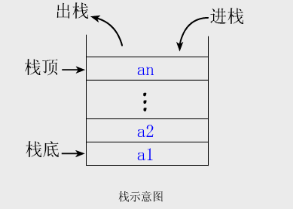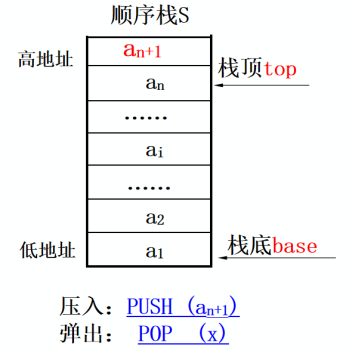栈
- 定义:只能在表的一端(栈顶)进行插入和删除运算的线性表
- 逻辑结构:一对一关系
- 存储结构
– 顺序栈
– 链栈 - 运算规则:只能在栈顶运算,且访问结点时依照后进先出(LIFO)或先进后出(FILO)的原则
- 实现方式
– 入栈
– 出栈
– 读栈顶元素值
– 建栈
– 判断栈空
– 判断栈慢
– 清空栈
– 销毁栈
栈的表示和操作的实现



顺序栈的C++代码实现
#include<iostream>
using namespace std;
#define OVERFLOW -2
#define OK 1
#define NULL 0
#define ERROR -1
#define MAXSIZE 100 // 最大空间
typedef int SElemType;
typedef int Status;
typedef struct {
SElemType* base;
SElemType* top;
int stacksize;
}SqStack;
// 顺序栈初始化
Status InitStack(SqStack& S) {
S.base = new SElemType[MAXSIZE];
if (!S.base) return OVERFLOW;
S.top = S.base;
S.stacksize = MAXSIZE;
return OK;
}
// 判断顺序栈是否为空
bool StackEmpty(SqStack S) {
if (S.top == S.base) return true;
else return false;
}
// 判断是否为满栈
bool StackFull(SqStack S) {
if (S.top - S.base >= S.stacksize)
return true;
else return false;
}
// 顺序栈的长度
int StackLength(SqStack S) {
return S.top - S.base;
}
// 输出栈顶元素
Status Gettop(SqStack S, SElemType& e) {
// SElemType* p;
if (StackEmpty(S)) // 栈空
return ERROR;
// p = S.top - 1;
// e = *p;
e = *(S.top - 1);
return OK;
}
// 入栈
Status Push(SqStack& S, SElemType e) {
if (StackFull(S)) // 满栈
return ERROR;
*S.top++ = e;
// *S.top = e;
// S.top ++;
return OK;
}
// 出栈
Status Pop(SqStack& S, SElemType& e) {
if (StackEmpty(S)) // 栈空
return ERROR;
e = *--S.top;
// S.top --;
// e = *S.top;
return OK;
}
// 清空顺序栈
Status ClearStack(SqStack& S) {
// S.stacksize = 0;
if(S.base) S.top = S.base;
cout << "清空成功!" << endl;
return OK;
}
// 销毁顺序栈
Status DestroyStack(SqStack& S) {
if (S.base) {
delete S.base;
S.stacksize = 0;
S.base = S.top = NULL;
}
cout << "销毁成功!" << endl;
return OK;
}
// 输入
void Creat(SqStack& S, int m) {
int i;
SElemType x;
for (i = 1; i < m + 1; i++) {
cout << "请输入第" << i << "个元素: ";
cin >> x;
Push(S, x);
// S.stacksize++;
}
}
// 输出
void OutPut(SqStack S) {
SElemType* p;
p = S.base;
while (p < S.top)
cout << *p++ << " ";
cout << endl;
}
int main()
{
int m;
SElemType e;
SqStack S;
/*---------------测试--------------*/
InitStack(S);
cout << "请输入栈的长度: ";
cin >> m;
Creat(S, m);
cout << "栈中元素为: ";
OutPut(S);
cout << "顺序栈的长度为: ";
cout << StackLength(S) << endl;
// 入栈测试
cout << "请输入入栈元素: ";
cin >> e;
Push(S, e);
cout << "栈中元素为: ";
OutPut(S);
cout << "顺序栈的长度为: ";
cout << StackLength(S) << endl;
// 获取栈顶元素测试
Gettop(S, e);
cout << "栈顶元素为: " << e <<endl;
cout << "顺序栈的长度为: ";
cout << StackLength(S) << endl;
// 出栈测试
Pop(S, e);
cout << "弹出的元素为: " << e << endl;
cout << "栈中元素为: ";
OutPut(S);
cout << "顺序栈的长度为: ";
cout << StackLength(S) << endl;
// 清空测试
ClearStack(S);
cout << "顺序栈的长度为: ";
cout << StackLength(S) << endl;
// 销毁测试
DestroyStack(S);
return 0;
}请输入栈的长度: 3请输入第1个元素: 1请输入第2个元素: 2请输入第3个元素: 3栈中元素为: 1 2 3顺序栈的长度为: 3请输入入栈元素: 7栈中元素为: 1 2 3 7顺序栈的长度为: 4栈顶元素为: 7顺序栈的长度为: 4弹出的元素为: 7栈中元素为: 1 2 3顺序栈的长度为: 3清空成功!顺序栈的长度为: 0销毁成功!正文完